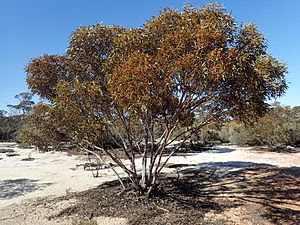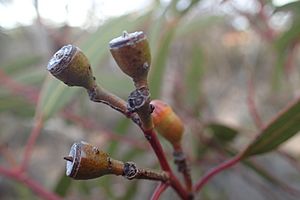Capped mallee facts for kids
Quick facts for kids Capped mallee |
|
|---|---|
 |
|
| Eucalyptus pileata growing near Mount Madden dam, south of Lake King | |
| Scientific classification | |
| Genus: |
Eucalyptus
|
| Species: |
pileata
|
The Eucalyptus pileata, often called the capped mallee, is a special type of mallee tree. It grows naturally in parts of South Australia and Western Australia. This unique plant has smooth, grey bark and long, narrow leaves. Its flowers are white, and its fruit looks like a small cup or barrel.
Contents
What is the Capped Mallee?
The Capped Mallee is usually a mallee, which means it's a shrubby tree with many stems growing from the ground. It can grow to be about 3.5 to 8 meters (11 to 26 feet) tall. This plant has a special underground part called a lignotuber. This helps it regrow after fires.
Bark and Leaves
The bark of the Capped Mallee is smooth and grey. It peels off in long strips, showing new bark underneath that can be orange or yellow.
When the plant is young, its leaves are egg-shaped and bluish-green. As the plant gets older, the leaves become long and narrow, like a spear. They are shiny green on both sides.
Flowers and Fruit
The Capped Mallee produces white flowers. These flowers grow in groups of seven. You can see them blooming from February to May or from September to October.
After flowering, the plant forms woody fruits. These fruits are shaped like a cup, cone, or barrel. They are about 6 to 10 millimeters long.
How Was it Named?
The Capped Mallee, Eucalyptus pileata, was first officially described in 1934. A botanist named William Blakely wrote about it in his book, A Key to Eucalypts. He found samples of the plant near Ravensthorpe.
The name pileata comes from a Latin word meaning "wearing a pileus." A pileus was a type of felt cap. This name refers to the cap-like shape of the flower bud's top part.
Where Does the Capped Mallee Grow?
You can find the Capped Mallee in both Western Australia and South Australia.
In Western Australia
In Western Australia, it grows in shrubland areas. These areas are found between towns like Balladonia, Kondinin, Norseman, Nugadong, and Ravensthorpe.
In South Australia
In South Australia, the Capped Mallee lives on the Eyre Peninsula. It is mostly found between the Hincks Conservation Park and Cummins.
Is it Protected?
The Western Australian Government's Department of Parks and Wildlife has classified this eucalypt as "not threatened." This means it is not currently at risk of disappearing.



